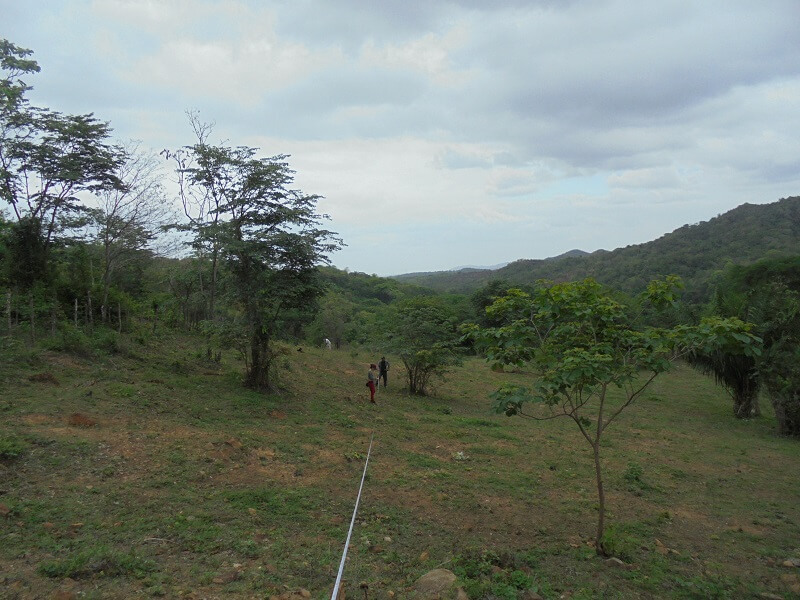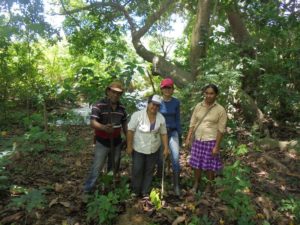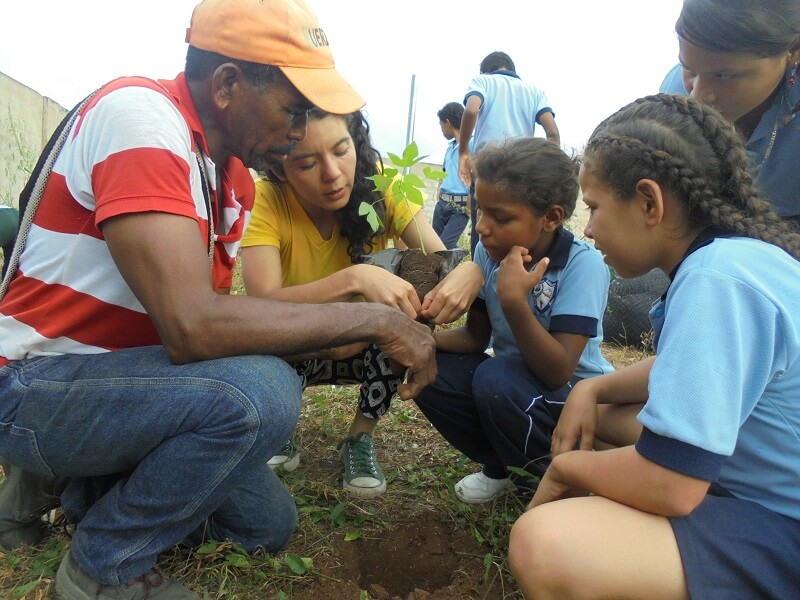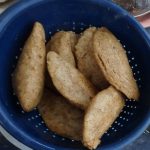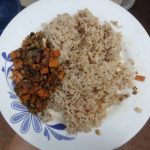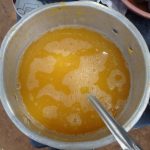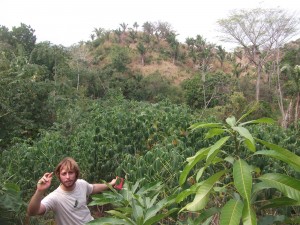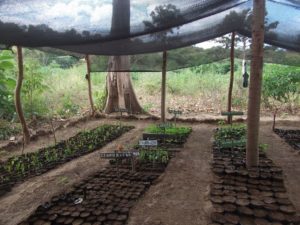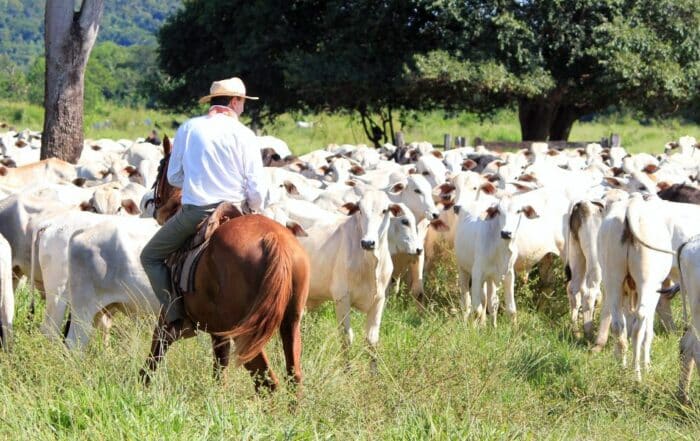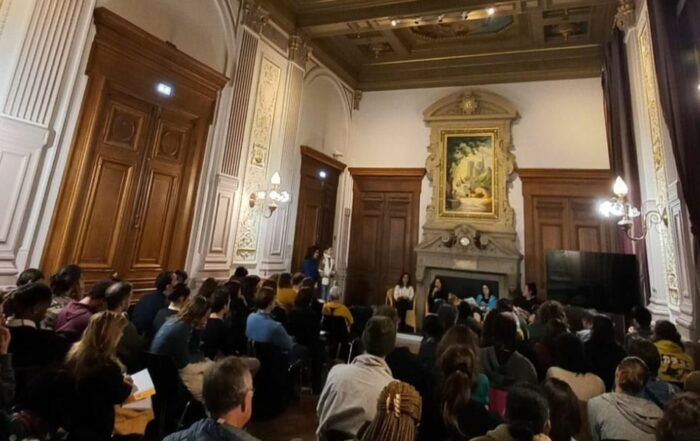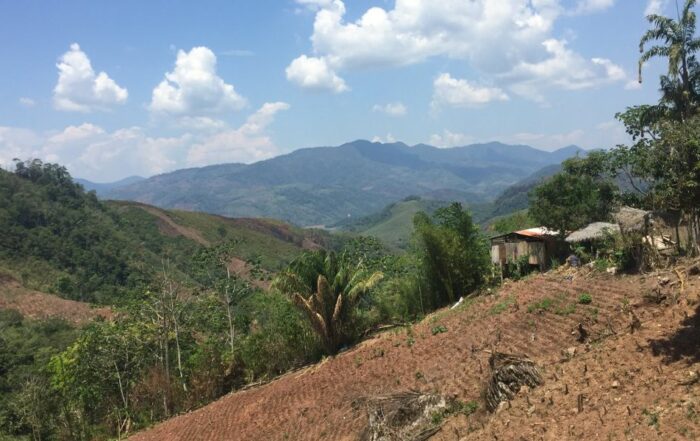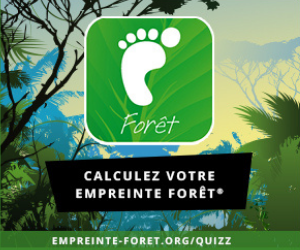June 2018
Rain and tree-planting
Despite climate change, the rains finally returned – a golden opportunity for us to plant 265 trees.
The rains were long overdue: after six months of drought (a particularity of dry tropical forests) and an additional long spell without rain (a consequence of climate change) the Guajira department of Colombia finally donned its green cloak of vegetation in May.
An evolution in the landscape and the farmers’ motivation to reforest their plots of land. In all, Envol Vert helped the seven farmers plant 202 trees in areas designated for agroforestry and 57 native species for ecological conservation on the banks of the rio Jerez. Once the planting was finished, the nurseries were repaired and prepared ready to welcome the new seeds which should germinate next month.
In a wave of enthusiasm, volunteers and farmers went together to the Camapana Nuevo school to raise awareness along the children of the benefits trees bring to us all and to plant 6 papaya trees within the school grounds.
November 2016
Maya Nut-based Cuisine in Santa Rita
On November 27th, Envol Vert organized a training event on the use of the Maya Nut for women of the Santa Rita community. The training was carried out by Daris, a beneficiary of the project, who was trained on the topic by Envol Vert in 2012. From now on, she is the one taking over as trainer for the community! Goal: Appropriation and perpetuation of the project promoting Maya Nut use by the community.
The schedule consisted of:
- An explanation of the nutritional properties of the Maya Nut and of its ecological value for reforestation and the agroforestry systems
- Differentiation of the seeds to be sown from the ones to be used for cooking
- Demo on the construction of a dryer for the Maya Nuts
- Application of the seeds transformation process: roasting of the pre-dried seeds, then molding of the beans until they become powder
- Maya Nut-based cooking and tasting in the village
On the menu : Maya Nut coffee, rice and Maya Nut-based veggies, empanadas made with Maya Nut-based veggies and Maya Nut tamarillo juice.
Maya Nut based dishes and drinks won over the crowd !
July 2016
Replacing the trees along the rivers of Palomino
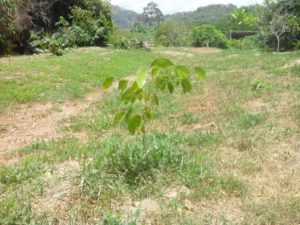 On July second, the processes of reforestation along the borders of the Palomino river, were recommenced after a year. 30 young trees of different species have now been planted along the border of the river, on the side of the farm “Pura Vida”. The process of reforestation originally began in October 2015, but was unfortunately halted by the strong draught, which prevented the trees from growing properly. The draught lasted until the middle of 2016, and we’re now enjoying a milder climate, which hopefully will enable us to replace the dead trees.
On July second, the processes of reforestation along the borders of the Palomino river, were recommenced after a year. 30 young trees of different species have now been planted along the border of the river, on the side of the farm “Pura Vida”. The process of reforestation originally began in October 2015, but was unfortunately halted by the strong draught, which prevented the trees from growing properly. The draught lasted until the middle of 2016, and we’re now enjoying a milder climate, which hopefully will enable us to replace the dead trees.
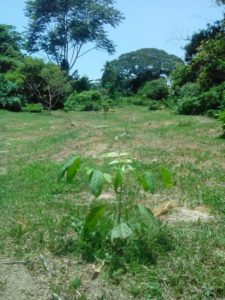 Among the plant species are the Noyer Maya (Brosimum alicastrum), the Tambor (Schizolobium parahyba), le Caracolí (Anacardium excelsium), the Ficus insipide (Ficus insípida), the Roble (Tabebuia rosae). These species were all harvested in the plant nursery of Palomino, which we hope will promote the local initiatives for conservation and the pave the road for employment. The next step of the reforestation process, will take place in the higher lying borders of the river. On these sites we will build fences, in order to protect the zone from animals, which could potentially damage the growing plants.
Among the plant species are the Noyer Maya (Brosimum alicastrum), the Tambor (Schizolobium parahyba), le Caracolí (Anacardium excelsium), the Ficus insipide (Ficus insípida), the Roble (Tabebuia rosae). These species were all harvested in the plant nursery of Palomino, which we hope will promote the local initiatives for conservation and the pave the road for employment. The next step of the reforestation process, will take place in the higher lying borders of the river. On these sites we will build fences, in order to protect the zone from animals, which could potentially damage the growing plants.
This above-mentioned process is determined by an agreement signed between the owner of the “Pura Vida” farm and Envol Vert. The agreement will ensure an equal distribution of responsibilities concerning the maintenance and continuity of the newly planted zone.
June 2016
New beneficiaries join the project
On June 18th, we held a meeting with new farmers, future beneficiaries of the project, so to demonstrate the validity of implementing reforestation of the Santa Rita de la Sierra area. 7 farmers were present. We discussed with them about the objectives and the structure of the project that Envol Vert propels but mainly about the validity of implementing sustainable production systems on their plots. They visited the nursery and were able to identify the forest and fruit trees there. The positive results of the project these past few months and the discussions that occurred with the first beneficiaries challenged new people, including people from outside the immediate area of the project. During the meeting, we explained the principles and actions of agroforestry and its multiple benefits at the socio-economic and environmental levels, and as well why we did choose the Maya Walnut tree as emblematic specie.
May 2016
We multiply information channels such as the screening of short documentaries on crop association, so to raise people awareness and make people understand that everyone can take action at its own level.
Agroforestry is the way!
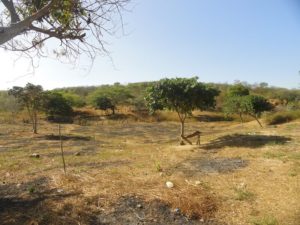 For quite a while Envol Vert has worked with –and welcomed the advice from Nicolas Maraval, an agriculturist and specialist in permaculture and agro-organic systems. His insight and valuable advice has been highly valuable to the two volunteers Camille and Nathan. Together we have provided knowledge and useful tools to a group of beneficiaries, regarding the natural sources of the forest and the dynamics of forestry regeneration. All of the participants were highly motivated to apply the system of agroforestry on parts of their land. With Nicolas’ support we have been able to begin the agroforestry approach and technique on Mauricio and Sonia’s farm. They are couple that are part of the beneficiaries of the project.
For quite a while Envol Vert has worked with –and welcomed the advice from Nicolas Maraval, an agriculturist and specialist in permaculture and agro-organic systems. His insight and valuable advice has been highly valuable to the two volunteers Camille and Nathan. Together we have provided knowledge and useful tools to a group of beneficiaries, regarding the natural sources of the forest and the dynamics of forestry regeneration. All of the participants were highly motivated to apply the system of agroforestry on parts of their land. With Nicolas’ support we have been able to begin the agroforestry approach and technique on Mauricio and Sonia’s farm. They are couple that are part of the beneficiaries of the project.
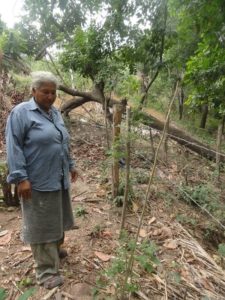 Together we have developed a design system for beginning the process of agroforestry. This includes creating specific target goals, drawing and mapping the area of deforestation, selecting the plant and tree species Etc. We have also marked the planted trees to ensure a higher visibility and therefore improve the care and ensure subsequent monitoring of the trees. The forest grounds have been covered in mulch and we have also set up fences around the area to prevent the entrance of animals. This was very interesting work, and it lasted all day! The goal is essentially to copy this process on all agricultural farms that are part of the project, before the rain season arrives. We have no time to lose!
Together we have developed a design system for beginning the process of agroforestry. This includes creating specific target goals, drawing and mapping the area of deforestation, selecting the plant and tree species Etc. We have also marked the planted trees to ensure a higher visibility and therefore improve the care and ensure subsequent monitoring of the trees. The forest grounds have been covered in mulch and we have also set up fences around the area to prevent the entrance of animals. This was very interesting work, and it lasted all day! The goal is essentially to copy this process on all agricultural farms that are part of the project, before the rain season arrives. We have no time to lose!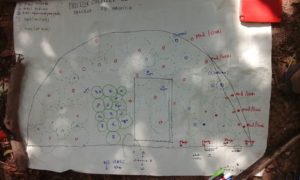
April 2016
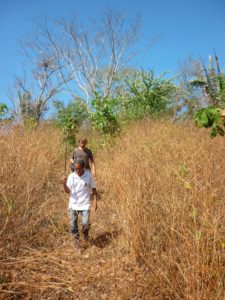 Now that the beneficiary group is well defined, it has been possible to characterise how each individual family will benefit from and use the new agricultural tools.
Now that the beneficiary group is well defined, it has been possible to characterise how each individual family will benefit from and use the new agricultural tools.
Doing individual surveys and research has given us the opportunity to obtain information concerning the kind of agriculture that is being done by the farmers. With the help of the latter, we drew and mapped their pieces of land and included the main elements that define their agriculture.
We then conducted an observation of the land to help us understand the problems of each beneficiary and find solutions to their specific agricultural needs and/or problems. These solutions should be environmentally sustainable and should better the ecosystem in general. The solutions should also be socially sustainable and thus accepted and supported by the beneficiaries of the project. Lastly the solutions must also be economically sustainable and should provide the farmers with a profitable deal.
Thus it has been suggested that each family can develop and cultivate an acre of their land with agroforestry. Agroforestry is a useful solution to the current agricultural challenges, concerning food safety and the need for new forms of production and consumption, in light of the current environmental crisis.
March 2016
Envol Vert’s projects in Santa Rita de La Sierra are showing positive results!
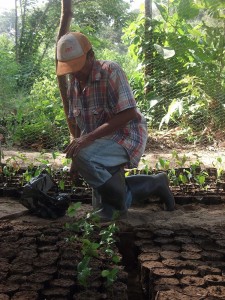 The plant nursery is almost done, and all the seeds of the different plant and tree species have been planted. These types of plants and trees have been chosen as the result of thorough research, in order to determine which plant species would most easily adapt to the natural conditions, and which species were of most interest and use to the beneficiaries. Since official seed and plant markets do not exist, the seeds are distributed informally on slots of land owned by farmers or by Envol Vert’s contacts, for example the Palomino fruit juice stores.
The plant nursery is almost done, and all the seeds of the different plant and tree species have been planted. These types of plants and trees have been chosen as the result of thorough research, in order to determine which plant species would most easily adapt to the natural conditions, and which species were of most interest and use to the beneficiaries. Since official seed and plant markets do not exist, the seeds are distributed informally on slots of land owned by farmers or by Envol Vert’s contacts, for example the Palomino fruit juice stores.
To enforce sharing among the beneficiaries, they are highly encouraged to collect seeds from their own land and plant them in our nursery in order to provide more plant species among their fellow farmers.
At the moment more than 3000 seeds have been planted and around 1000 have already germinated at the nursery. Among them there is the Noyer Maya, but also pioneering vegetables sorts (for example leucaena ) fruits (mango, avocado, oranges and tangerines) medicinal plants (moringa) tree’s for timber (cedro caoba, master) as well as other local plant species.
In order to ensure regular maintenance of the nursery, a rotating schedule system has been setup. Three times a week, a group of 3-4 people, are in charge of watering, weeding out and checking the plants for diseases or animals.
June 2018
Rain and tree-planting
Despite climate change, the rains finally returned – a golden opportunity for us to plant 265 trees.
The rains were long overdue: after six months of drought (a particularity of dry tropical forests) and an additional long spell without rain (a consequence of climate change) the Guajira department of Colombia finally donned its green cloak of vegetation in May.
An evolution in the landscape and the farmers’ motivation to reforest their plots of land. In all, Envol Vert helped the seven farmers plant 202 trees in areas designated for agroforestry and 57 native species for ecological conservation on the banks of the rio Jerez. Once the planting was finished, the nurseries were repaired and prepared ready to welcome the new seeds which should germinate next month.
In a wave of enthusiasm, volunteers and farmers went together to the Camapana Nuevo school to raise awareness along the children of the benefits trees bring to us all and to plant 6 papaya trees within the school grounds.
November 2016
Maya Nut-based Cuisine in Santa Rita
On November 27th, Envol Vert organized a training event on the use of the Maya Nut for women of the Santa Rita community. The training was carried out by Daris, a beneficiary of the project, who was trained on the topic by Envol Vert in 2012. From now on, she is the one taking over as trainer for the community! Goal: Appropriation and perpetuation of the project promoting Maya Nut use by the community.
The schedule consisted of:
- An explanation of the nutritional properties of the Maya Nut and of its ecological value for reforestation and the agroforestry systems
- Differentiation of the seeds to be sown from the ones to be used for cooking
- Demo on the construction of a dryer for the Maya Nuts
- Application of the seeds transformation process: roasting of the pre-dried seeds, then molding of the beans until they become powder
- Maya Nut-based cooking and tasting in the village
On the menu : Maya Nut coffee, rice and Maya Nut-based veggies, empanadas made with Maya Nut-based veggies and Maya Nut tamarillo juice.
Maya Nut based dishes and drinks won over the crowd !
July 2016
Replacing the trees along the rivers of Palomino
 On July second, the processes of reforestation along the borders of the Palomino river, were recommenced after a year. 30 young trees of different species have now been planted along the border of the river, on the side of the farm “Pura Vida”. The process of reforestation originally began in October 2015, but was unfortunately halted by the strong draught, which prevented the trees from growing properly. The draught lasted until the middle of 2016, and we’re now enjoying a milder climate, which hopefully will enable us to replace the dead trees.
On July second, the processes of reforestation along the borders of the Palomino river, were recommenced after a year. 30 young trees of different species have now been planted along the border of the river, on the side of the farm “Pura Vida”. The process of reforestation originally began in October 2015, but was unfortunately halted by the strong draught, which prevented the trees from growing properly. The draught lasted until the middle of 2016, and we’re now enjoying a milder climate, which hopefully will enable us to replace the dead trees.
 Among the plant species are the Noyer Maya (Brosimum alicastrum), the Tambor (Schizolobium parahyba), le Caracolí (Anacardium excelsium), the Ficus insipide (Ficus insípida), the Roble (Tabebuia rosae). These species were all harvested in the plant nursery of Palomino, which we hope will promote the local initiatives for conservation and the pave the road for employment. The next step of the reforestation process, will take place in the higher lying borders of the river. On these sites we will build fences, in order to protect the zone from animals, which could potentially damage the growing plants.
Among the plant species are the Noyer Maya (Brosimum alicastrum), the Tambor (Schizolobium parahyba), le Caracolí (Anacardium excelsium), the Ficus insipide (Ficus insípida), the Roble (Tabebuia rosae). These species were all harvested in the plant nursery of Palomino, which we hope will promote the local initiatives for conservation and the pave the road for employment. The next step of the reforestation process, will take place in the higher lying borders of the river. On these sites we will build fences, in order to protect the zone from animals, which could potentially damage the growing plants.
This above-mentioned process is determined by an agreement signed between the owner of the “Pura Vida” farm and Envol Vert. The agreement will ensure an equal distribution of responsibilities concerning the maintenance and continuity of the newly planted zone.
June 2016
New beneficiaries join the project
On June 18th, we held a meeting with new farmers, future beneficiaries of the project, so to demonstrate the validity of implementing reforestation of the Santa Rita de la Sierra area. 7 farmers were present. We discussed with them about the objectives and the structure of the project that Envol Vert propels but mainly about the validity of implementing sustainable production systems on their plots. They visited the nursery and were able to identify the forest and fruit trees there. The positive results of the project these past few months and the discussions that occurred with the first beneficiaries challenged new people, including people from outside the immediate area of the project. During the meeting, we explained the principles and actions of agroforestry and its multiple benefits at the socio-economic and environmental levels, and as well why we did choose the Maya Walnut tree as emblematic specie.
May 2016
We multiply information channels such as the screening of short documentaries on crop association, so to raise people awareness and make people understand that everyone can take action at its own level.
Agroforestry is the way!
 For quite a while Envol Vert has worked with –and welcomed the advice from Nicolas Maraval, an agriculturist and specialist in permaculture and agro-organic systems. His insight and valuable advice has been highly valuable to the two volunteers Camille and Nathan. Together we have provided knowledge and useful tools to a group of beneficiaries, regarding the natural sources of the forest and the dynamics of forestry regeneration. All of the participants were highly motivated to apply the system of agroforestry on parts of their land. With Nicolas’ support we have been able to begin the agroforestry approach and technique on Mauricio and Sonia’s farm. They are couple that are part of the beneficiaries of the project.
For quite a while Envol Vert has worked with –and welcomed the advice from Nicolas Maraval, an agriculturist and specialist in permaculture and agro-organic systems. His insight and valuable advice has been highly valuable to the two volunteers Camille and Nathan. Together we have provided knowledge and useful tools to a group of beneficiaries, regarding the natural sources of the forest and the dynamics of forestry regeneration. All of the participants were highly motivated to apply the system of agroforestry on parts of their land. With Nicolas’ support we have been able to begin the agroforestry approach and technique on Mauricio and Sonia’s farm. They are couple that are part of the beneficiaries of the project.
 Together we have developed a design system for beginning the process of agroforestry. This includes creating specific target goals, drawing and mapping the area of deforestation, selecting the plant and tree species Etc. We have also marked the planted trees to ensure a higher visibility and therefore improve the care and ensure subsequent monitoring of the trees. The forest grounds have been covered in mulch and we have also set up fences around the area to prevent the entrance of animals. This was very interesting work, and it lasted all day! The goal is essentially to copy this process on all agricultural farms that are part of the project, before the rain season arrives. We have no time to lose!
Together we have developed a design system for beginning the process of agroforestry. This includes creating specific target goals, drawing and mapping the area of deforestation, selecting the plant and tree species Etc. We have also marked the planted trees to ensure a higher visibility and therefore improve the care and ensure subsequent monitoring of the trees. The forest grounds have been covered in mulch and we have also set up fences around the area to prevent the entrance of animals. This was very interesting work, and it lasted all day! The goal is essentially to copy this process on all agricultural farms that are part of the project, before the rain season arrives. We have no time to lose!
April 2016
 Now that the beneficiary group is well defined, it has been possible to characterise how each individual family will benefit from and use the new agricultural tools.
Now that the beneficiary group is well defined, it has been possible to characterise how each individual family will benefit from and use the new agricultural tools.
Doing individual surveys and research has given us the opportunity to obtain information concerning the kind of agriculture that is being done by the farmers. With the help of the latter, we drew and mapped their pieces of land and included the main elements that define their agriculture.
We then conducted an observation of the land to help us understand the problems of each beneficiary and find solutions to their specific agricultural needs and/or problems. These solutions should be environmentally sustainable and should better the ecosystem in general. The solutions should also be socially sustainable and thus accepted and supported by the beneficiaries of the project. Lastly the solutions must also be economically sustainable and should provide the farmers with a profitable deal.
Thus it has been suggested that each family can develop and cultivate an acre of their land with agroforestry. Agroforestry is a useful solution to the current agricultural challenges, concerning food safety and the need for new forms of production and consumption, in light of the current environmental crisis.
March 2016
Envol Vert’s projects in Santa Rita de La Sierra are showing positive results!
 The plant nursery is almost done, and all the seeds of the different plant and tree species have been planted. These types of plants and trees have been chosen as the result of thorough research, in order to determine which plant species would most easily adapt to the natural conditions, and which species were of most interest and use to the beneficiaries. Since official seed and plant markets do not exist, the seeds are distributed informally on slots of land owned by farmers or by Envol Vert’s contacts, for example the Palomino fruit juice stores.
The plant nursery is almost done, and all the seeds of the different plant and tree species have been planted. These types of plants and trees have been chosen as the result of thorough research, in order to determine which plant species would most easily adapt to the natural conditions, and which species were of most interest and use to the beneficiaries. Since official seed and plant markets do not exist, the seeds are distributed informally on slots of land owned by farmers or by Envol Vert’s contacts, for example the Palomino fruit juice stores.
To enforce sharing among the beneficiaries, they are highly encouraged to collect seeds from their own land and plant them in our nursery in order to provide more plant species among their fellow farmers.
At the moment more than 3000 seeds have been planted and around 1000 have already germinated at the nursery. Among them there is the Noyer Maya, but also pioneering vegetables sorts (for example leucaena ) fruits (mango, avocado, oranges and tangerines) medicinal plants (moringa) tree’s for timber (cedro caoba, master) as well as other local plant species.
In order to ensure regular maintenance of the nursery, a rotating schedule system has been setup. Three times a week, a group of 3-4 people, are in charge of watering, weeding out and checking the plants for diseases or animals.

